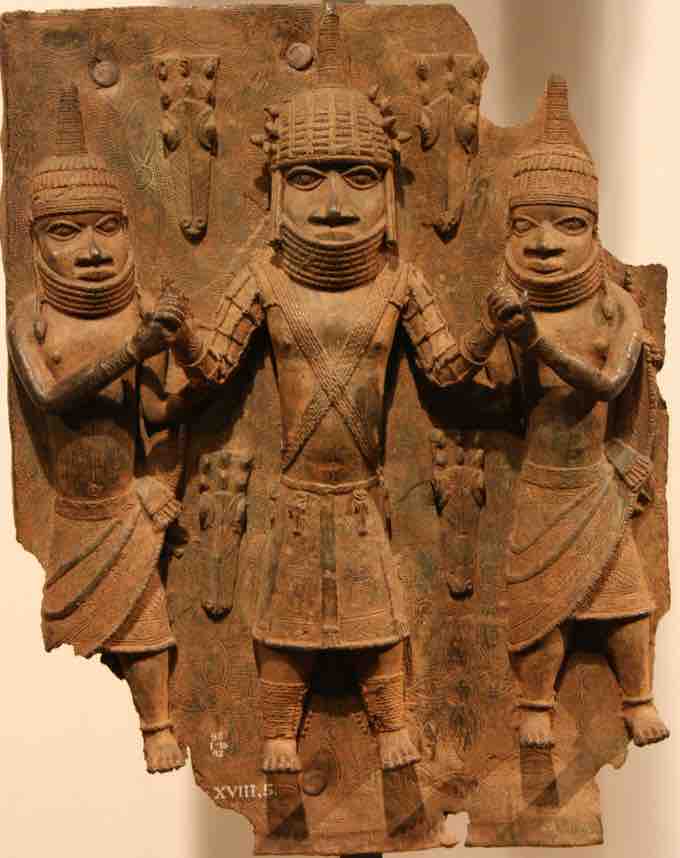Overview: The Benin Bronzes
The Benin Bronzes are a collection of more than 3,000 brass plaques and sculptures from the royal palace of the Kingdom of Benin, located in present day Nigeria. Collectively, the plaques form the best known examples of Benin art created by the Edo people from the 13th century; other forms of Benin art consist of additional sculptures in brass or bronze, including some famous portrait heads and smaller pieces.
History and Seizure of the Bronzes
Bronzes are believed to have been cast in Benin since the 13th century, and some of the Benin Bronzes in the collection date from the 15th and 16th centuries. Today, it is clear that the bronzes were made in Benin from an indigenous culture, centuries before contact with Portuguese traders. It is believed that two "golden ages" in Benin metal workmanship occurred during the reigns of Esigie (1550) and of Eresoyen (1735-50), when their workmanship achieved its highest qualities.
At the end of the 19th century, most of the plaques and other objects were removed by the British during the Punitive Expedition of 1897 as imperial control was being consolidated in Southern Nigeria. Two hundred of the pieces were taken to the British Museum in London, while the rest were purchased by other European museums. Today, a large number are held by the British Museum. Other notable collections are in Germany and the United States. In 1936, Oba Akenzua II, the traditional leader of the Edo people in Nigeria, began a movement to return the art to its proper place in Nigeria; however, only two of the 3,000 bronzes were returned by the end of his reign in 1978. Nigeria has since bought around 50 Bronzes from the British Museum and has repeatedly called for the return of the remainder.
Production and Style
While the collection is known as the Benin Bronzes, like most West African "bronzes," the pieces are mostly made of brass of variable composition. There are also pieces made of wood, ceramic, ivory, and mixtures of bronze and brass, among other materials. The metal pieces were made using lost-wax casting and are considered among the best sculptures made using this technique.
The lost wax method
Modern-day view of bronze casting using the lost wax method. The molten metal is poured into the mold.
The Bronzes depict a variety of images, including animals, fish, humans, and scenes of court life. Some of the reliefs represent important battles of the 16th-century wars of expansion; however, the majority depict noble dignitaries wearing splendid ceremonial dress. Most of the plaques portray static figures either alone, in pairs, or in small groups arranged hierarchically around a central figure. They were cast in matching pairs, although each was individually made. The bronzes are more naturalistic than most African art of the period, and the surfaces are designed to highlight contrasts between light and metal. The features of many of the heads are exaggerated from natural proportions, with large ears, noses, and lips, which are shaped with great care. The most notable aspect of the works is the high level of the great metal-working skill at lost-wax casting.
Benin Bronzes
Two Benin bronzes in London's Victoria and Albert Museum
Function and Importance
Bronze and ivory objects had a variety of functions in the ritual and courtly life of the Kingdom of Benin. They were used principally to decorate the royal palace, which contained many bronze works; many were hung on the pillars of the palace by nails punched directly through them. As a courtly art, their principal objective was to glorify the Oba—the divine king—and the history of his imperial power or to honor the queen mother. Art in the Kingdom of Benin took many forms, of which bronze and brass reliefs and the heads of kings and queen mothers are the best known. Bronze receptacles, bells, ornaments, jewelry, and ritual objects also possessed aesthetic qualities and originality, demonstrating the skills of their makers, although they are often eclipsed by figurative works in bronze and ivory carvings.
An important aspect of the works is their exclusivity: property was reserved only for certain social classes, reflecting the strict hierarchical structure of society in the Kingdom of Benin. In general, only the king could own objects made of bronze and ivory; however, he could allow high-ranking individuals to use such items, such as hanging masks and cuffs made of bronze and ivory.

Benin Brass Plaque
The Oba of Benin with attendants and Europeans.